#Benz Injection
Explore tagged Tumblr posts
Text
Providing top-quality Mercedes Benz Injection Parts for your vehicle needs. 🚗🔧
2 notes
·
View notes
Text


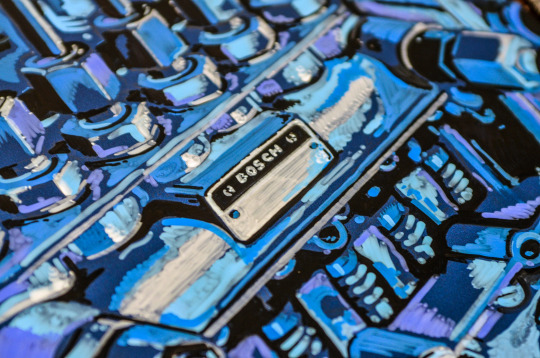



The Official Black Forest Bosch Fuel Injection Pump Shop sign.
24x24"
Acrylic on metal sign.
#drawing#illustration#draw#milwaukee#art#classic car#black forest#mercedes#mercedes benz#classic benz#bosch#fuel injection pump#bosch legacy#benz#handmade#painting
0 notes
Text

1959 Mercedes 300SL Roadster
Elvis Presley with his 1959 Mercedes 300SL Roadster.
A closer look at the 1959 Mercedes 300SL Elvis bought while stationed in Germany from 1958-60. In this picture, Elvis is standing with movie producer Hal Wal.
The Mercedes-Benz 300SL was one of the most advanced sports cars of its era, featuring a lightweight tubular frame and the first production fuel-injected engine.
64 notes
·
View notes
Text

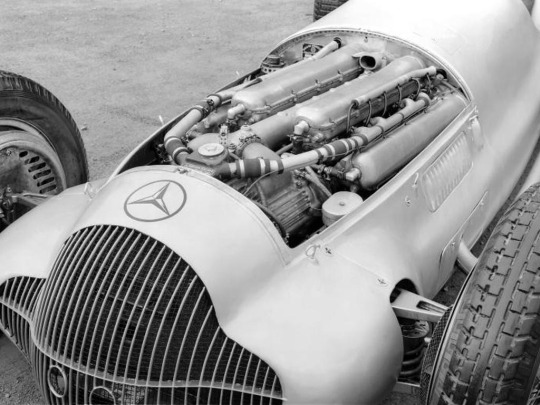
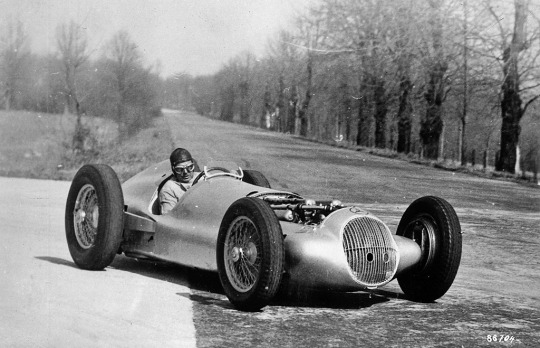
1938 Mercedes-Benz W154
In September 1936, the AIACR (Association Internationale des Automobile Clubs Reconnus), the governing body of motor racing, set the new Grand Prix regulations effective from 1938. Key stipulations included a maximum engine displacement of three liters for supercharged engines and 4.5 liters for naturally aspirated engines, with a minimum car weight ranging from 400 to 850 kilograms, depending on engine size.
By the end of the 1937 season, Mercedes-Benz engineers were already hard at work developing the new W154, exploring various ideas, including a naturally aspirated engine with a W24 configuration, a rear-mounted engine, direct fuel injection, and fully streamlined bodies. Ultimately, due to heat management considerations, they opted for an in-house developed 60-degree V12 engine designed by Albert Heess. This engine mirrored the displacement characteristics of the 1924 supercharged two-liter M 2 L 8 engine, with each of its 12 cylinders displacing 250 cc. Using glycol as a coolant allowed temperatures to reach up to 125°C. The engine featured four overhead camshafts operating 48 valves via forked rocker arms, with three cylinders combined under welded coolant jackets, and non-removable heads. It had a high-capacity lubrication system, circulating 100 liters of oil per minute, and initially utilized two single-stage superchargers, later replaced by a more efficient two-stage supercharger in 1939.
The first prototype engine ran on the test bench in January 1938, and by February 7, it had achieved a nearly trouble-free test run, producing 427 hp (314 kW) at 8,000 rpm. During the first half of the season, drivers such as Caracciola, Lang, von Brauchitsch, and Seaman had access to 430 hp (316 kW), which later increased to over 468 hp (344 kW). At the Reims circuit, Hermann Lang's W154 was equipped with the most powerful version, delivering 474 hp (349 kW) and reaching 283 km/h (176 mph) on the straights. Notably, the W154 was the first Mercedes-Benz racing car to feature a five-speed gearbox.
Max Wagner, tasked with designing the suspension, had an easier job than his counterparts working on the engine. He retained much of the advanced chassis architecture from the previous year's W125 but enhanced the torsional rigidity of the frame by 30 percent. The V12 engine was mounted low and at an angle, with the carburetor air intakes extending through the expanded radiator grille.
The driver sat to the right of the propeller shaft, and the W154's sleek body sat close to the ground, lower than the tops of its tires. This design gave the car a dynamic appearance and a low center of gravity. Both Manfred von Brauchitsch and Richard Seaman, whose technical insights were highly valued by Chief Engineer Rudolf Uhlenhaut, praised the car's excellent handling.
The W154 became the most successful Silver Arrow of its era. Rudolf Caracciola secured the 1938 European Championship title (as the World Championship did not yet exist), and the W154 won three of the four Grand Prix races that counted towards the championship.
To ensure proper weight distribution, a saddle tank was installed above the driver's legs. In 1939, the addition of a two-stage supercharger boosted the V12 engine, now named the M163, to 483 hp (355 kW) at 7,800 rpm. Despite the AIACR's efforts to curb the speed of Grand Prix cars, the new three-liter formula cars matched the lap times of the 1937 750-kg formula cars, demonstrating that their attempt was largely unsuccessful. Over the winter of 1938-39, the W154 saw several refinements, including a higher cowl line around the cockpit for improved driver safety and a small, streamlined instrument panel mounted to the saddle tank. As per Uhlenhaut’s philosophy, only essential information was displayed, centered around a large tachometer flanked by water and oil temperature gauges, ensuring the driver wasn't overwhelmed by unnecessary data.
101 notes
·
View notes
Text
1956 Mercedes-Benz 300SL
Gullwing 🩶
The 300SL was one of the 1st production cars equipped with direct fuel injection, significantly enhancing its power and efficiency, making it one of the fastest cars of its time.
🇩🇪 #classic #icon
11 notes
·
View notes
Text
1968 began the onset of a slew of Neue Klasse” range of BMW’s after a 5 year hiatus and catapulted BMW out of near bankruptcy and it’s design dynamism with emphasis on performance plus luxury dominated Mercedes-Benz, it’s primary competitor back then.

Cue the arrival of something rather special, the likes of which this segment had never seen: a classy sedan boasting the performance, poise and assurance of a sports car. Its newly developed engine was to write a new chapter in BMW history with its variants from 2.5 liters to 3.3 liters.
2.8 L M30B28 Inline 6 cylinder.
Gearbox type: 3 Speed Automatic transmission
Power: (KW / HP):125 / 170
Displacement: (ccm):2788
Torque: 234lbs
Fuel system: Carburetor
(Fuel injection from 1971 onwards)
Acceleration: 10.5 seconds
Too Speed: 193km/ 120mph
#bmwlove#bmw#bmw motorsport#automotive#bmwlife#auto show#automobile#muscle car#auto news#bmw lovers#bmw classic#bmw cars#bmwmotorrad#bmwedit
5 notes
·
View notes
Text
Debunking the Myth of.. “The Car That Saved BMW”
It’s a refrain that you’ll often hear among car enthusiasts and beyond: “That’s the car that saved BMW!” ..The quirky Isetta, the rear-engined and economical 700, the pivotal 1500, and the beloved 2002 often get crowned as BMW��s saviors, but that catchy platitude falls short. Cars don’t—and can’t—rescue companies. People, smart strategies, and, on occasion, a timely financial boost do all of the heavy lifting.

Take the Isetta in the late 1950s. With BMW teetering financially after World War II, this oddball microcar won over buyers seeking cheap transportation. Its success stemmed from BMW’s shrewd decision to license and produce it—a stopgap that bought the company time. Then, in 1959, Herbert Quandt, a major shareholder, injected capital and restructured the company, thwarting a takeover by Daimler-Benz and paving the way for a real turnaround. The 700, launched that same year, further steadied the ship with strong sales into the early 1960s, reinforcing Quandt’s confidence in BMW’s future. The BMW 1500 followed, laying the 'New Class' groundwork with its sporty appeal, but it was the 2002 that truly landed on most car enthusiasts’ radars later in the decade. The 2002’s success amplified the brand’s new direction, leaning on visionary engineering and Quandt’s earlier financial lifeline—not just its own charm.

It’s tempting to anthropomorphize cars—they inspire passion—but they lack agency. They don’t generate revenue, shift markets, or innovate alone. Those feats belong to the leaders, engineers, and, in BMW’s case, a financier like Herbert Quandt who kept the engine running.

So, the next time you hear somebody exclaim: “That’s the car that saved BMW!” ..Kindly remind them that cars don’t save companies—people and strategies do because a vehicle can’t innovate or earn revenue on its own. The car was merely one of many cogs and was not the mechanic.
#bmw#classic#vintage#classic car#bmw 2002#bmw isetta#bmw 1500#bmw 700#herbert quandt#the car that saved bmw#classic and vintage bmw
3 notes
·
View notes
Text
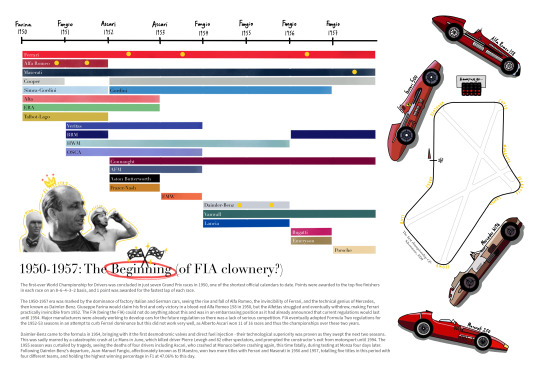
F1: a colorised history 1/10 - text and graphics mine with thanks to Wikipedia and Reddit
text in photo below the cut :) if you spot any mistakes please let me know!
The first-ever World Championship for Drivers was concluded in just seven Grand Prix races in 1950, one of the shortest official calendars to date. Points were awarded to the top five finishers in each race on an 8–6–4–3–2 basis, and 1 point was awarded for the fastest lap of each race. The 1950-1957 era was marked by the dominance of factory Italian and German cars, seeing the rise and fall of Alfa Romeo, the invincibility of Ferrari, and the technical genius of Mercedes, then known as Daimler-Benz. Giuseppe Farina would claim his first and only victory in a blood-red Alfa Romeo 158 in 1950, but the Alfettas struggled and eventually withdrew, making Ferrari practically invincible from 1952. The FIA (being the FIA) could not do anything about this and was in an embarrassing position as it had already announced that current regulations would last until 1954. Major manufacturers were already working to develop cars for the future regulation so there was a lack of serious competition. FIA eventually adopted Formula Two regulations for the 1952-53 seasons in an attempt to curb Ferrari dominance but this did not work very well, as Alberto Ascari won 11 of 16 races and thus the championships over these two years, remaining the last Italian driver to do so. Daimler-Benz came to the formula in 1954, bringing with it the first desmodromic valves and direct fuel injection - their technological superiority was proven as they swept the next two seasons. This was sadly marred by a catastrophic crash at Le Mans in June, which killed driver Pierre Levegh and 82 other spectators, and prompted the constructor's exit from motorsport until 1994. The 1955 season was curtailed by tragedy, seeing the deaths of four drivers including Ascari, who crashed at Monaco before crashing again, this time fatally, during testing at Monza four days later. Following Daimler-Benz’s departure, Juan-Manuel Fangio, affectionately known as El Maestro, won two more titles with Ferrari and Maserati in 1956 and 1957, totalling five titles in this period with four different teams, and holding the highest winning percentage in F1 at 47.06% to this day.
#timeline#this is basically as close to fanart as i will ever get#tiny drawings of the 1950s cars#this was so ridiculously fun to do#can you believe it stemmed from watching seb name the wdcs in order one too many times#halfway through my fifth rewatch i was like#hey i don't really know about half of these people..#and so now i have taken it upon myself to do a Full And Comprehensive history of motorsport...#anyway i hope this is useful or at least nice to look at :")#because a lot of timeline spreadsheets ive seen are just uh. unusable#claire's edits#alberto ascari#juan manuel fangio#giuseppe farina#classic f1#f1#formula 1#i lowkey feel like this was designed very badly............... but OK#this was created for an audience of one (1) and that's me.#<3
19 notes
·
View notes
Text
it's Crab who does the saving. of course it is, the nurse, the silent, confident, so very calm one of them. the one who loves Benzedrine more than he could ever speak. of course it is. but he's not calm, and he's not confident. he is not the doctor. he's not meant to be. he's always been meant to be the support. that's where he thrives, where he was born to be. of course he would be the nurse. his heart is pounding and he's breathing fast, too fast, and sweating, he can feel it. he's terrified that he's wrong, that he's going to be wrong, that he's going to do something wrong and kill Benze instead of save him. he can't get the moment out of his head. the split second, not ten minutes ago, walking into the station and Benze on a chair, slumped over the table, unresponsive. he thinks his heart stopped, but it's beating too hard for asystole right now. he knows diagnostics. Benze taught him this. he knows what an overdose looks like not because of books the way Benze learned it but because he's seen it happen before. not often, but when partiers in the Zones get their hands on City drugs, they're prone to taking it too far. this isn't party drugs, though. that isn't Benze. the bottle on the table, empty but for a drop, reads morphine. Crab thinks of this morning, before they'd left for the track. Benze had been down, and hard, with a headache. he said it was normal. he said it was fine. but he hid under a blanket and groaned whenever Sandman or Donnie talked too loud. he'd been in pain. how long has this been happening? how bad has it gotten to warrant this? how desperate must he have been the first time to stop the pain? how hadn't Crab known? he'd sat on the edge of the bed before leaving and kissed Benzedrine's temple. he's morbidly glad for that. fatalistic, but if that's the last interaction they'll ever have had, at least it was that. his hands are shaking when he signs at Sandman and Donnie, either or, whoever has more presence of mind, to find- he doesn't have the time to fingerspell it. Benze's lips are turning blue. he's not responding to- the word is stimuli. the sign is a mimicry of poking someone. so it's Crab who retrieves the medicine, of course it is, of course it's Crab. this vial is labeled kloxxado. Benze called it naloxone when he found it in their inventory the first time. Crab's hands are shaking as he preps a new injection. most things work fastest intravenously. the blood does it. the heart does it. his heart is thumping out of control. his heart is beating just to keep Benze's the same. his best friend doesn't even respond when he sticks the needle into his arm. Benze might be the one who’s dying (he can’t die, Crab won’t let him, of course he won’t, he can’t-) but Crab thinks maybe he’s only alive for Benze. like maybe if Benze dies he will too. like maybe the only thing keeping his heart beating is the fluttering pulse he can feel as he holds onto Benze’s wrist. he feels like he’s gonna pass out but he does all the right things, keeps his best friend alive despite himself because of course he does. he’s the caregiver. he’s the nurse. his heart is beating for this. (his heart is beating for Benze)
#maybe im still stuck on this but i still can’t make it into like. a proper fic#so i’m just writing wild stream of consciousness posts about it#you can read this however you want tbh i’m not really thinking a whole ton about it#like my intent is (with like two exceptions and neither of them are in these fandoms) never really for stuff to be romantic#but like sure go off then! i know a lot of stuff i write is very easily read either way and i kinda like it like that#idk why i feel like i have to give this caveat every time i write smth i think i just feel bad for Not shipping anything so i feel like i#have to explain myself somehow. ok im done now though#just a final general PSA that i prefer platonic/ambiguous stuff to shipping and now i’ll try to stop repeating that with every post skksksj#anyway#she speaks!#she writes!#ddas#idk i think maybe at some point i’ll have to write smth dealing with how crab has this ‘of course it falls to me’ mindset#like he’s almost everyone else’s emotional support friend but maybe those (at least half self-imposed) expectations have to weigh on him#hmmmm
7 notes
·
View notes
Text
A Look at Mercedes’ Electric Future: The EQ Series
The Evolution of Mercedes: From Classics to Modern Marvels
Mercedes-Benz is more than just a luxury car brand—it’s a symbol of innovation, performance, and prestige that has shaped the automotive industry for over a century. From its early roots in classic automobiles to the modern marvels gracing today’s roads, Mercedes has remained a pioneering force, consistently blending timeless elegance with cutting-edge technology. This blog takes you on a journey through the evolution of Mercedes-Benz, highlighting key milestones that have solidified its reputation as an icon of the automotive world.
The Early Days: Birth of a Legend
Mercedes-Benz traces its origins back to the late 19th century when Karl Benz and Gottlieb Daimler laid the foundation for modern automobiles. In 1886, Karl Benz created the Benz Patent-Motorwagen, often considered the first true automobile. Around the same time, Daimler and Wilhelm Maybach built a vehicle with a gasoline-powered engine. These early developments set the stage for the future of Mercedes-Benz.
The brand's official birth came in 1926 when Daimler-Motoren-Gesellschaft (DMG) merged with Benz & Cie to form Mercedes-Benz. The combination of the two companies brought together their strengths in engineering and innovation, establishing a brand that would redefine luxury and performance in the automotive world.
1930s: Setting Standards with the Mercedes 500K and 540K
The 1930s saw Mercedes-Benz rise to prominence as a producer of high-performance, luxury vehicles. The Mercedes 500K and 540K models became symbols of automotive excellence, featuring powerful engines, streamlined designs, and unparalleled craftsmanship. These models were the epitome of luxury, favored by royalty, celebrities, and influential figures of the time. The 540K, with its supercharged 5.4-liter engine, became an icon, blending speed with opulence in a way that few others could match.
1950s: The Birth of an Icon with the 300SL
Fast-forward to the post-World War II era, and Mercedes-Benz continued to push boundaries with the introduction of the Mercedes 300SL in 1954. Known for its distinctive gullwing doors, the 300SL was the fastest production car of its time and the first to feature direct fuel injection. This iconic sports car not only redefined speed and performance but also embodied the elegance and sophistication that would become synonymous with the Mercedes brand.
The 300SL also set the stage for Mercedes’ dominance in motorsport, especially in Formula One and endurance racing, further cementing its reputation as a leader in performance engineering.
1960s-1980s: Innovation and Expansion
The mid-20th century saw Mercedes-Benz expanding its lineup to cater to a broader audience. The introduction of the Mercedes S-Class in the 1970s revolutionized the luxury sedan segment, becoming the benchmark for comfort, safety, and technological innovation. With features like anti-lock brakes (ABS), airbags, and advanced suspension systems, Mercedes made safety a key component of luxury.
During this period, Mercedes also introduced the G-Class (G-Wagen) in 1979, a rugged, military-inspired SUV that quickly became a favorite for off-road enthusiasts while still delivering the luxury and quality expected from the brand.
1990s: A New Era of Performance with AMG
In the 1990s, Mercedes-Benz entered a new era of performance with its acquisition of AMG, a tuning company that specialized in high-performance variants of Mercedes models. The collaboration brought the birth of the Mercedes-AMG lineup, featuring powerful V8 engines and enhanced driving dynamics. Models like the AMG E55 and the AMG C36 became favorites for drivers seeking both luxury and blistering performance.
The AMG division quickly grew into a central part of the brand’s identity, representing the pinnacle of performance engineering while maintaining Mercedes’ commitment to comfort and style.
2000s-Present: Redefining Luxury and Technology
The 21st century has been marked by a continued push for innovation. Mercedes-Benz has seamlessly integrated advanced technology into its vehicles, offering drivers a suite of features designed for convenience, safety, and entertainment. Innovations such as the Mercedes-Benz User Experience (MBUX) system, semi-autonomous driving capabilities, and active safety features like collision prevention and lane-keeping assist have become standard in many models.
Mercedes has also embraced the electric future with the introduction of its EQ lineup. The Mercedes EQS, launched in 2021, represents the brand’s commitment to sustainability without compromising on luxury or performance. With its fully electric drivetrain, cutting-edge battery technology, and premium interior, the EQS positions Mercedes at the forefront of the electric vehicle revolution.
Mercedes Today: A Symbol of Prestige
Today, Mercedes-Benz stands as a global leader in the luxury automobile industry, continuously setting benchmarks in performance, safety, and technology. Whether it's the elegance of the S-Class, the versatility of the G-Class, or the eco-conscious innovation of the EQ series, Mercedes-Benz has mastered the art of blending tradition with modernity.
Conclusion: A Legacy of Excellence
From the early days of Karl Benz’s first motor vehicle to the cutting-edge electric cars of the 21st century, Mercedes-Benz has evolved into an automotive powerhouse. Its legacy is built on a commitment to pushing the boundaries of design, engineering, and luxury. As the brand continues to innovate and adapt to new technologies, one thing remains clear: Mercedes-Benz will always be a symbol of excellence and a leader in the automotive world.

1 note
·
View note
Text
Meet the Awesome Volkswagen Golf GTI [2022]

In a world where time waits for no man, inventors and users making several means of beating time through the speed of vehicles and other transportation means. Yes that's the world we live in. Since ancient days of January 1886 that was when a man named carl Benz first came up with this fantastic idea of inventing these wheeled animals we call CARS.
Now let me present to you the VOLKSWAGEN GOLF, a very Agile Brand of the German cars with it's medium sized body shaped like a blue shark. Firstly you know Germans are known world wide for their strong talent and skills in inventing powerful cars that stand out in the automobile game. Well, based on research in 2022 the Volkswagen GTI was launched in Wolfsburg Germany where the largest plant is based and in there, so many other varieties of Volkswagen models are being manufactured and can be transported to any part of the world with the help of their trust worthy team to ensure that the vehicles get to you safe and sound.
If you've been searching for a sturdy compact car to get, The Volkswagen Golf GTI could be a very great option for you.
What's so good about this Volkswagen Golf?
Of course there are so many good sides of this automobile animal you should know about.
The Volks is built with a direct fuel injection system which makes the engine burn fuel more efficiently and results in more engine agility, cleaner emissions and increased fuel economy. And this can be ideal for any kind of driver, whether you take fair tax trips or just run errands around town you do not have to worry about the fuel consumption.
You might want to know what makes it so special?
The impressive vehicle has a perfect body frame built for sportiness and sophistication. With its small but powerful tires, dashing on the roads with it's lightening speed getting you to your destination in no time like a newly launched rocket.
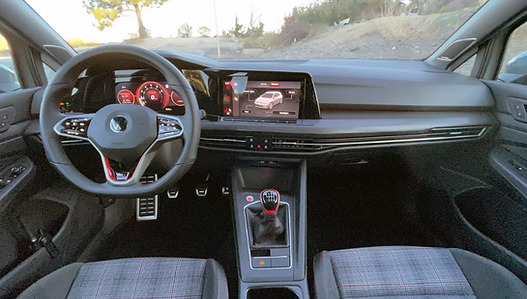
In the world of automobiles, Volkswagen Golf will forever remain one of the most efficient and durable cars the Germans have manufactured in years past till now. The invention of the Volkswagen Golf has really impacted a lot in the racing sports. Golf is well known world wide for it's racing abilities and mostly produced for the sake of racers, though families enjoy their casual rides in it as well.
Cheers to the brand!
3 notes
·
View notes
Text
Brazil going green amid US$8bn local electric vehicle production plans

Brazil is turning the page toward electric vehicles (EV) with nearly US$8 billion in private sector investments aimed at kicking off the production of new EV models and their components on Brazilian soil.
In addition to new EV models from traditional legacy brands such as Audi (Q8 e-tron), BMW (iX1, i7), Chevrolet (Bolt), Fiat (500e Abarth), Ford (Mach E), Mercedes Benz (EQE SUV), Renault (Megane E-tech) coming to the Brazilian market in 2023, three automakers will actually be producing EVs locally in the country in 2024.
While US-based Argentine owned BMC (Bravo Motor Company) is investing US$5bn in local production, Chinese automaker GWM (Great Wall Motors) is injecting some US$2bn toward production, and its Chinese counterpart BYD (Build Your Dreams) is investing approximately US$600mn, the latter two taking place in existing factories.
Continue reading.
#brazil#politics#brazilian politics#economy#environmentalism#auto industry#mod nise da silveira#image description in alt
8 notes
·
View notes
Text
The Ultimate Turbo Upgrade for the OM606 Engine: What You Need to Know
When it involves extracting most performance out of your Mercedes OM606 diesel engine, deciding on the right turbocharger is key. Known for its strong layout and high tuning potential, the OM606 responds rather well to rapid improvements. But what turbo is exceptional for the OM606 engine? The answer depends to your goals—each day using, racing, or off-street performance—but there are established alternatives that strike a super balance of electricity, reliability, and response. Benz Injection, a depended on name in diesel overall performance, gives rapid systems tailored for each OM606 and OM605 Turbo setups.

Performance Gains with OM605 Turbo on OM606 Setup
One popular choice for OM606 proprietors is upgrading with an OM605 Turbo setup. This turbo variant supplies quicker spool, better throttle response, and strong midrange torque—perfect for day by day driving or mild towing. Benz Injection provides high-overall performance OM605 turbos designed to bolt onto the OM606 platform with minimal adjustments.
Benz Injection’s Custom Turbo Solutions
For those trying to push the OM606 engine past factory limits, Benz Injection gives custom-built faster kits. These are engineered to deal with excessive raise applications whilst preserving engine sturdiness. Whether you want a road-friendly setup or a tune-focused build, Benz Injection's rapid systems supply the power and precision fans demand.
Matching Turbo Size with Driving Needs
Turbo size topics. A large OM605 Turbo from Benz Injection can offer excessive-give up power gains however may additionally introduce lag. A smaller rapid offers faster reaction for town use. Identifying your driving fashion will guide the excellent faster healthy.
Reliability and Support
Benz Injection now not only affords exceptional OM605 Turbo kits but additionally gives tuning guidance, elements support, and installation recommendations. With their understanding, OM606 proprietors can increase overall performance without sacrificing reliability.
Conclusion
The high-quality rapid on your OM606 engine blends performance with dependability. With Benz Injection's OM605 Turbo answers, you get bot—tailor-made electricity and established engineering.
0 notes
Text
Unlock Precision and Performance with AST Tools from Tillman Tools, LLC
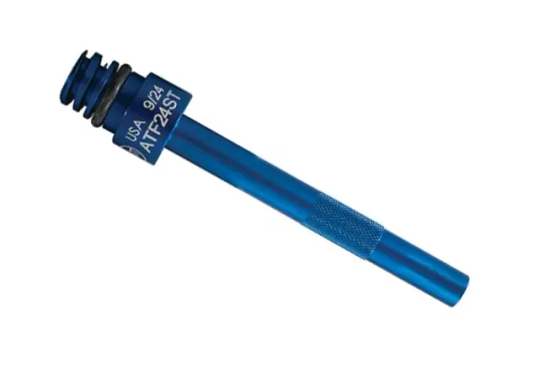
When it comes to professional-grade automotive repair and diagnostics, precision and durability are non-negotiable. For decades, AST Tools have set the standard in specialty tool performance across the automotive industry. From European car diagnostics to high-accuracy engine service tools, AST (Assenmacher Specialty Tools) delivers unmatched quality and compatibility for technicians who refuse to compromise. At Tillman Tools, LLC, we proudly supply a full range of AST Tools, trusted by mechanics, government agencies, educators, and enthusiasts alike.
Why Choose AST Tools for Your Shop or Garage
Automotive service today is more complex than ever. Vehicle manufacturers are incorporating more advanced systems, tighter tolerances, and specialized materials. This shift has created a growing demand for tools that do more than just "get the job done"—they must do it right the first time.
AST Tools are designed to meet these modern challenges. Manufactured in the USA, these tools are known for:
OEM Compatibility – Engineered specifically for domestic, European, and Asian vehicles
Superior Material Quality – High-grade steel and heat treatment for long life
Specialty Functionality – Timing kits, cooling system service tools, brake tools, transmission tools, and more
Time-Saving Designs – Faster, safer repair processes with minimal guesswork
Whether you are servicing a BMW, Audi, Ford, or Toyota, AST Tools offer the precision fit and reliability that today’s vehicles demand.
Top Categories of AST Tools Available at Tillman Tools
As an authorized distributor of AST Tools, Tillman Tools provides a wide array of products suited for both professional repair shops and vocational institutions. Our inventory includes:
1. Engine Timing Tools
One of AST’s most popular product lines, engine timing tools are designed for accuracy and durability. These kits include camshaft locking tools, crankshaft alignment pins, and tensioners specific to engines from VW, Audi, BMW, Mercedes-Benz, and more. Avoid costly mistakes with tools designed to match factory specs.
2. Cooling System Tools
Cooling system failures are a common repair item, and AST Tools offers pressure testers, coolant fill kits, radiator adapters, and thermostat removal tools. These tools are built to handle the complexities of closed-loop and pressurized systems used in modern engines.
3. Brake Service Tools
AST provides comprehensive solutions for ABS systems, caliper piston tools, brake fluid pressure tools, and bleeder kits. These specialty tools help speed up brake jobs while improving safety and accuracy.
4. Fuel & Emissions Tools
Technicians working on emission system repairs or fuel line maintenance will appreciate AST’s fuel injection test kits, EVAP system testing tools, and fuel pressure adapters—all essential for modern diagnostics and compliance with emission standards.
5. Transmission and Drivetrain Tools
Service automatic or manual transmissions with the correct AST solutions, including clutch alignment tools, fluid adapters, transmission holding fixtures, and more. These tools are essential for maintaining manufacturer-recommended service intervals and avoiding internal damage.
6. Specialty European Tools
AST excels in tools for European models such as Audi, VW, BMW, and Mercedes-Benz. From camshaft locks to harmonic balancer pullers, these tools make dealership-level service possible in independent shops and training centers.
Trusted by Professionals Nationwide
AST Tools are the preferred choice for a wide variety of customers:
Automotive technicians and repair shops
Vocational schools and technical training programs
Fleet and dealership service departments
Military and government maintenance facilities
DIY enthusiasts who demand top-tier tools
At Tillman Tools, we’re proud to support the professionals who rely on this industry-leading brand for accurate and efficient repairs.
Why Buy AST Tools from Tillman Tools, LLC
With over 50 years of serving professionals across the automotive, aviation, and marine industries, Tillman Tools, LLC is your trusted source for premium tools and support. When you shop with us, you gain access to:
A curated selection of AST Tools
Competitive pricing with bulk order discounts
Personalized customer service
Fast, secure nationwide shipping
Technical support and tool recommendations
We don’t just sell tools—we provide solutions that keep your operation running smoothly and efficiently.
Conclusion
When quality, precision, and dependability matter most, AST Tools are the professional’s choice. At Tillman Tools, LLC, we proudly supply these superior tools to mechanics, educators, and institutions who value long-term performance and OEM compatibility. Whether you're performing a complex timing job or routine brake service, we have the AST Tools to get it done right.
Contact Here:
Tillman Tools, LLC 14050 Cherry Ave Ste R PMB 1003 Fontana, CA 92337
Mail Here! Phone: 909-334-4400 Email: [email protected] Customer Service: Mon - Fri 8am - 5pm CST
0 notes
Text
The Timeless Journey of Mercedes: A Legacy in Motion

Source: mercedes-benz.com
Few brands in the automotive industry hold as much prestige and historical value as Mercedes-Benz. The brand is synonymous with innovation, luxury, and engineering prowess and has set the standard for quality cars worldwide. Mercedes’ company history is not merely that of a car maker—it’s a tale of technological achievements, visionary creators, and an unrelenting quest for perfection that transformed the world automotive industry.
Origins: The Invention of the Automobile
Mercedes’ company history dates back to the late 19th century, when two innovative German engineers, Karl Benz and Gottlieb Daimler, independently invented some of the first gasoline-powered vehicles. In 1886, Karl Benz invented the world’s first true car, the Benz Patent-Motorwagen. Around the same time, Daimler and his partner Wilhelm Maybach were working on similar motorised carriages.
While working independently, both inventors’ innovations formed the foundation of the contemporary automobile industry. Their innovations are regarded as the foundation of Mercedes’ heritage, which was established before the official establishment of the brand.
The Birth of Mercedes
Source – mercedesarizona.com
The brand “Mercedes” was born out of Emil Jellinek, a powerful auto dealer and entrepreneur who was an early admirer of Daimler’s cars. In 1900, Jellinek ordered a new range of cars in the name of his daughter, Mercedes. The new car—the Mercedes 35 HP—was an innovative vehicle of its time, forging new benchmarks in terms of design and performance.
By 1901, the “Mercedes” name had begun to catch on in the European market. The popularity of these early models ensured the reputation of the brand, and in 1902, Daimler-Motoren-Gesellschaft (DMG) registered “Mercedes” as a trademark.
The Merger: Formation of Mercedes-Benz
The contemporary Mercedes company history officially commenced in 1926 when Daimler-Motoren-Gesellschaft and Benz & Cie merged to create the company we know today as Mercedes-Benz. This was a strategic union primarily motivated by economic imperatives in post-World War I Germany and the imperative to merge resources in a more competitive automobile market.
The new company’s logo—a laurel wreath surrounding a three-pointed star—was a combination of Daimler and Benz’s original logos. The star’s three points signified Daimler’s vision to rule transport on land, water, and in the air.
Engineering Milestones and Innovation
During the 20th century, Mercedes-Benz established a reputation for excellence in engineering, innovation, and safety. Among its main technological milestones:

1936: Inauguration of the 260 D, the world’s first mass-produced diesel passenger car.
1951: Introduction of the “crumple zone” that improves the safety of passengers in the event of a crash.
1954: Introduction of the legendary Mercedes-Benz 300 SL Gullwing, remembered for its signature upward-opening doors and innovative fuel injection system.
1978: First manufacturer to provide the Anti-lock Braking System (ABS), which marked a new generation of automotive safety.
These developments showcased the company’s consistent dedication to precision, safety, and performance, establishing Mercedes as a class apart from its peers.
Global Expansion and Prestige
After World War II, Mercedes’ company history began its new period of global expansion. As demand grew in North America and the emerging economies, Mercedes-Benz became a globally recognised brand.
By the 1980s and 1990s, Mercedes-Benz cars were status symbols globally. The S-Class was the gold standard of luxury sedans, and the G-Class set the standard for rugged luxury with its off-road features.
The company expanded its product line to include compact cars, luxury coupes, SUVS, and commercial vehicles, yet still held on to its reputation as a symbol of class and craftsmanship.
Sustainability and Technological Evolution
When the world entered the 21st century, Mercedes-Benz stepped boldly towards innovation in mobility and sustainability. Realising the increasing value of environmental responsibility, the company heavily invested in hybrid and electric technologies.
Mercedes’ serious foray into the electric vehicle (EV) segment came in 2016 with the launch of the EQ brand. The EQC and EQS models reveal not only Mercedes’ technical excellence but also its dedication to a greener future.
Mercedes-Benz also led the way in autonomous driving technology, combining AI-based systems such as DISTRONIC Plus, PRE-SAFE, and Drive Pilot that bring the company nearer to fully autonomous vehicles.
Also Read: Unfolding the Secrets of the Toyota Production System
Corporate Shifts and Global Footprint
The parent firm, Daimler AG, recently went through intense restructuring to intensify its focus. In 2021, Daimler spun off its truck business and rebranded itself as Mercedes-Benz Group AG, reaffirming its dedication to passenger cars and luxury mobility.
Mercedes-Benz nowadays operates factories in more than 20 nations, hiring thousands of employees and reaching millions of buyers. The “Made in Germany” heritage of the brand still holds a premium position in its psyche, yet its presence is unambiguously international.
The Brand in Pop Culture and Motorsports
Source – thebookseller.com
Any summary of Mercedes’ company history would not be exhaustive without addressing its long-established involvement in popular culture and motor sports.
Mercedes-Benz has been a reigning giant of Formula One auto racing, particularly with the Mercedes-AMG Petronas team. Under the guidance of legends such as Lewis Hamilton and fueled by high-performance design, the team has won several world championships.
Outside of the racetrack, Mercedes vehicles have appeared in hundreds of movies, television shows, and music videos. From James Bond to Fast & Furious, the brand’s elegant design and power have made it a Hollywood darling and beyond.
Also Read: You Won’t Believe the Price Tag! Meet the Most Expensive Car in the World
Challenges and the Road Ahead
With all its rich history, Mercedes’ company history is not without its pitfalls. From economic recessions and worldwide financial downturns to growing competition from technology-savvy electric vehicle manufacturers such as Tesla, Mercedes has had to continue evolving.
To counter this, the company has accepted digitalisation, bringing onboard capabilities such as smart connectivity features, over-the-air updates, and voice-assist technologies to its cars. Sustainability is at its core, with Mercedes-Benz planning to go fully electric in its key markets by 2030 and carbon neutral by 2039.
Conclusion: A Legacy in Motion
Mercedes’ company history is a fascinating story of survival, transformation, and unwavering determination to be perfect. From the initial gasoline car to electric sedans in the future, Mercedes-Benz not only keep up with progress—it leads it.
For over a century, the brand has remained a symbol of elegance and engineering excellence. As Mercedes-Benz steers into a future defined by sustainability and intelligent mobility, its legacy continues to shine on roads across the world.
Whether you’re looking at its history, technological achievements, or cultural impact, one thing is clear: Mercedes-Benz is not just about building cars—it’s about shaping the future of mobility.
0 notes
Text
"BUT YOU CAN NEVER LEAVE"
I used to hear Hotel California by The Eagles a lot and I used to be hooked to that beat and the overall instruments of that track. The overall mystery to what the lyrics meant and me trying my best to come up with possible explanations—The underlying mystery of the track did add to the experience and I felt that I really had discovered a track that had stood the test of time, both with its catchy construction and underlying mystery that made it sound like the crème de la crème of classic tracks from The Eagles.
No one will argue about the influence that Hotel California had on the music industry and the message it gave to the people in the industry. I was able to understand from various sources that the song really was about the music and Hollywood industry as a whole—basically inviting a person who was travelling down a "dark desert highway" without fear to chase their dreams, seek shelter as the person gets attracted to the "shimmering light" in the distance. This I feel signified a test to the dreamer, as that shelter would be like a shortcut he should never take. But his "head grew heavy" and his "sight grew dim" therefore he had to stay for the night.
There, in that hotel which symbolizes the above said industries, he sees wonders that shocks him and sees a pretty woman with all of her charm in the lobby, and he heard the "mission bell." Taking into account all the good things and bad things, he goes to chase her with all his might. Then she "lit up a candle" and showed him the way, and he heard the "voices down the corridor" and they were telling him how nice this hotel is and telling him to "bring" his "alibis."
Well, he learns that the girl he likes has a bit of expensive taste—i.e. "her mind is Tiffany twisted" and "she got that Mercedes-Benz." There is also one moment after this that the person says "she got a lotta pretty boys, who she just calls friends." Now although our narrator isn't able to understand this, those "friends" of hers were men just like him who came to the hotel. Neglecting all this, the narrator goes into a trance enjoying his time at the hotel—dancing, singing, and having a fun time at the boats. There is also a clear display of wit by using the lines "we haven't had that spirit here since 1969" when the narrator asks for wine from the boat captain. This line cleverly is an entendre where the line could be about the "spirit"—wine—or it could be about the energy that the narrator brings to the boat. This wine line could be the narrator celebrating an accolade in the above said industry.
The next section is what changes the narrative for me and led me to believe that it was about the above said industries. As the narrator goes into the night, he becomes uncomfortable. He sees "mirrors on the ceiling" and "pink champagne on ice"—could be signifying the grandeur of a good-looking hall or a room with chandeliers and champagne—where he sees that the people who he has been with all this time are "prisoners of their own device." And followed by what I feel like is what the narrator saw during the dinner, where he says that "in the master's chamber, they gathered for the feast, they stab it with their steely knives, but just can’t kill the beast." This line especially gives clues into what happens when someone tries to change the industry, injecting it with their own ideas and opinions—but at last the beast remains the same, i.e. the industry swallows them rather than the other way around. The narrator, shocked by these events, understands what a mistake he has done chasing the woman and runs to the lobby to check out and leave the place.
The nightman who was employed sees him and tells him to relax and that they are "programmed to receive." It also should be noted that the voice of the watchman is soulless and obsolete like a robot, and to the narrator's horror, tells him that "you can check out any time you like, but you can never leave"—showing us that the lifestyle that the people who have been conditioned in the above industry makes them chase it more, even after they want to escape. The girl symbolizes the riches and seductiveness that the industry shows to these young dreamers to attract them. The hotel shows them the lifestyle they can lead, and the fact that the narrator came to his senses and wanted to escape within a day shows the sheer pace of the industry trying to get to anyone that comes there, squeezing every bit of life out of them and then allowing them to leave—only for them to chase the life they left back.
This whole song forms a solid idea about the music and film industry that people are driven to and also proves its timelessness, as the whole fiasco of this song could be seen in actors and artists in the industry—and we ourselves can think of a lot of examples which fit the theme and meaning of this song.
Still leaves the question in my head though, why didn’t The Eagles let Frank Ocean sample this song though?
0 notes